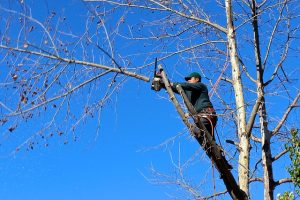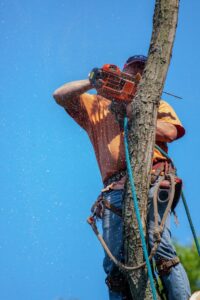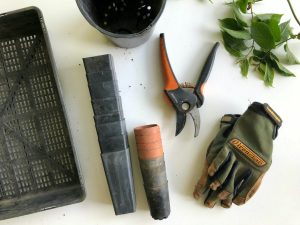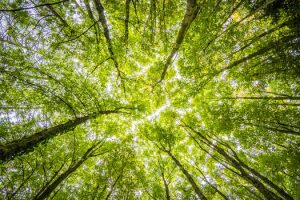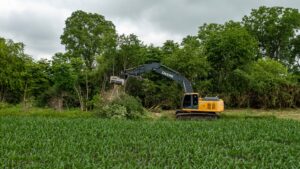Tree Trimming Service Near Me

Tree Trimming Service Near Me
Tree trimming, also known as pruning, is the process of removing dead, diseased, or overgrown branches from a tree in order to promote healthy growth and maintain its shape. This process is important for a variety of reasons including safety, aesthetic appeal, and the overall health of the tree. One of the most important reasons for tree trimming is safety. Dead or diseased branches can easily fall and cause damage to property or injury to people. Additionally, overgrown branches can grow into power lines, causing power outages or even starting fires. By removing these potentially dangerous branches, tree trimming can help prevent accidents and protect both people and property.
Another important reason for tree trimming is aesthetic appeal. Trees that are overgrown or have unshapely branches can detract from the beauty of a yard or landscape. By removing these branches, the tree’s natural shape and beauty can be restored, making it an attractive addition to any landscape.
Tree trimming is also important for the overall health of the tree. By removing dead or diseased branches, the tree can focus its energy on healthy growth. Additionally, trimming back overgrown branches allows light and air to penetrate the tree’s canopy, which can help prevent the growth of mold and mildew. This can also help reduce the risk of pests and diseases that thrive in dark, damp environments. There are several different techniques that can be used when trimming a tree, depending on the size and type of tree, as well as the specific purpose of the trimming. The three main types of tree trimming are crown cleaning, crown thinning, and crown reduction.
Tree services refer to a range of services related to the care and maintenance of trees. These services can include tree planting, pruning, shaping, cabling and bracing, fertilization, pest and disease management, and tree removal. Tree planting is the process of planting a new tree in a specific location. This can be done for various reasons, such as replacing a tree that has been removed, adding shade or beauty to a property, or improving the environment. Pruning is the process of removing dead, diseased, or damaged branches from a tree. This can be done for various reasons, such as to improve the tree’s overall health, remove branches that are interfering with power lines or buildings, or rove the tree’s appearance. Shaping is the process of trimming and pruning a tree to give it a specific shape. This can be done for aesthetic reasons or to improve the tree’s overall health. Cabling and bracing is the process of providing support to a tree by installing cables and/or braces. This can be done to help support a tree that is at risk of falling over, or to help support a tree that has been damaged by severe weather.
Crown reduction is the most drastic type of tree trimming. It involves removing a large portion of the tree’s canopy in order to reduce the overall size of the tree. This is typically done when a tree has grown too large for its location, or if it is causing damage to nearby structures. It is important to note that tree trimming should always be performed by a professional arborist. A professional arborist has the knowledge and equipment necessary to safely trim a tree, and can ensure that the tree is trimmed in a way that promotes healthy growth and prevents future problems.
Fertilization is the process of providing nutrients to a tree to help it grow and thrive. This can be done to improve a tree’s overall health or to help a tree recover from damage or disease. Pest and disease management is the process of identifying and treating pests and diseases that are affecting a tree. This can be done to improve a tree’s overall health or to prevent the spread of pests or diseases to other trees. Tree removal is the process of cutting down and removing a tree from a property. This can be done for a variety of reasons, such as to remove a tree that is dead or dying, to remove a tree that is causing damage or danger, or to clear land for development.
It’s important to note that tree services should be performed by licensed, trained professionals to avoid any damage to the tree or property, and also to ensure safety.
Tree services refer to a variety of services related to the care and maintenance of trees. These services can include tree pruning, tree removal, tree planting, stump grinding, and more. Tree services are typically provided by professional arborists, who are trained and certified in the proper care and maintenance of trees. Some tree services also include landscaping services, such as lawn care and garden maintenance.
Tree services refer to the various tasks and activities related to the care and maintenance of trees. Some examples of tree services include:
• Tree trimming and pruning: This involves removing dead or diseased branches, as well as shaping and shaping the tree to promote healthy growth and prevent potential hazards.
• Tree removal: This involves cutting down and removing a tree that is dead, diseased, or poses a danger to property or people.
• Stump grinding: This is the process of removing a tree stump by grinding it down to below ground level using a specialized machine.
• Planting and transplanting: This includes planting new trees, as well as transplanting existing trees to different locations.
• Tree health care: This includes diagnosing and treating diseases, pests, and other issues that may be impacting the health of a tree.
• Emergency tree services: This includes providing services for trees that have fallen or are in danger of falling due to severe weather or other reasons.
These are some examples of tree services, but there may be others that are specific to certain regions or industries.
When providing a proposal for a tree removal, an arborists also evaluate the site for stump grinding. While having the stump ground is not always necessary, many people prefer to deal with the stump at the same time as having the tree removed. Stump grinding allows the property owner to use the area where the tree once stood for laying sod or planting a flower bed. The stump grinder also produces mulch that has many uses around the yard. Here are answers to some common questions we get about stump grinding. Tree trimming is the process of removing dead, diseased, or overgrown branches from a tree to maintain its health and appearance. It is an important aspect of tree care, as it can help prevent damage to property and people, and can also improve the tree’s overall health and appearance.
There are several reasons why tree trimming is necessary. First, dead or diseased branches can pose a danger to people and property if they fall. Second, overgrown branches can interfere with power lines, sidewalks, and other structures. Third, trimming can help to promote the tree’s overall health by allowing sunlight and air to reach the inner parts of the tree, which can improve its growth and fruit production.
When it comes to trimming a tree, there are a few things to keep in mind. First, it is important to only remove branches that are dead, diseased, or overgrown. Removing healthy branches can harm the tree and can also lead to an unbalanced shape. Second, it is important to use the proper tools and techniques to avoid damaging the tree. Third, it is important to trim at the right time of year, as some trees have specific pruning needs and may be sensitive to certain types of trimming at certain times of the year.
One of the most important things to consider when trimming a tree is safety. Always wear protective gear, such as goggles, gloves, and a hard hat, and use a sturdy ladder or lift to reach high branches. It is also a good idea to work with a partner or to hire a professional tree trimming service to ensure that the job is done safely and correctly.
When it comes to the tools needed for tree trimming, there are a few basic items that you will need. A good pair of pruning shears, a chainsaw, and a pruning saw are the most essential tools. You may also need a ladder or lift, as well as a pair of safety goggles and gloves to protect yourself while working.
The first step in tree trimming is to identify the branches that need to be removed. Dead branches should be removed first, as they are the most likely to fall and cause damage. Diseased branches should also be removed, as they can spread their disease to the rest of the tree. Overgrown branches should be removed next, as they can interfere with power lines, sidewalks, and other structures.
Once you have identified the branches that need to be removed, it is time to start trimming. When trimming, it is important to make clean, precise cuts. Use a chainsaw or pruning saw to remove large branches, and use pruning shears for smaller branches. Make sure to cut the branch at a slight angle, so that water will run off of the cut. After the tree has been trimmed, it is important to clean up any debris that has fallen to the ground. This includes leaves, twigs, and branches. It is also a good idea to mulch the debris, as it can be used as a natural fertilizer for the tree.
About Heber City, Utah
Heber City is a city and county seat of Wasatch County, Utah, United States. The population was 16,856 at the time of the 2020 census. It is located 43 miles southeast of Salt Lake City.
Neighborhoods in Heber City, Utah
neighborhood painting & services, Heber City, Main Street Park, Provo Canyon Via Heber City, HEBER CITY, Ivory Homes - Beaufontaine, Heber City Park, Heber City Cemetery, Hamlet Homes: Brookside 2 Community, U-Haul Neighborhood Dealer, Southfield Park, Wheeler Park by Richmond American Homes, Deer Valley, Albion Basin, Heber, UT, Valley Station, Back 40 Ranch House Grill, Red Ledges, Melvin's Public House, Wasatch Aquatic Center
Things To Do in Heber City, Utah
Bus Stops in Heber City, Utah to Truco Services, Inc.
Bus Stop in Heber Valley Hospital Heber City, Utah to Truco Services, Inc.
Bus Stop in Wasatch School District Transportation Bid Heber City, Utah to Truco Services, Inc.
Bus Stop in S Main St & Wasatch Starbucks Heber City, Utah to Truco Services, Inc.
Bus Stop in S Main St & Wasatch McDonald's Heber City, Utah to Truco Services, Inc.
Bus Stop in Wasatch Commons & US 40 Heber City, Utah to Truco Services, Inc.
Bus Stop in N Main St & E 500 N NB (Smith's) Heber City, Utah to Truco Services, Inc.
Bus Stop in N Main St & 500 N (Holiday Lanes) Heber City, Utah to Truco Services, Inc.
Bus Stop in W 1000 S & S 100 w WB Heber City, Utah to Truco Services, Inc.
Bus Stop in S 300 W & W 1080 S (Walmart) Heber City, Utah to Truco Services, Inc.
Bus Stop in S Main St & 1200 S NB Heber City, Utah to Truco Services, Inc.
Bus Stop in Deer Mountain Heber City, Utah to Truco Services, Inc.
Bus Stop in Summit Bike Share Heber City, Utah to Truco Services, Inc.
Driving Directions in Heber City, Utah to Truco Services, Inc.
Driving Directions from Heber Tree Service to 4640 Commerce Dr, Murray, UT 84107, USA
Driving Directions from Wasatch Arborists Inc. to 4640 Commerce Dr, Murray, UT 84107, USA
Driving Directions from Seven Trees Tree Experts to 4640 Commerce Dr, Murray, UT 84107, USA
Driving Directions from Park City Landscape & Snow Removal, Inc. to 4640 Commerce Dr, Murray, UT 84107, USA
Driving Directions from Visentin Tree & Pest Control to 4640 Commerce Dr, Murray, UT 84107, USA
Reviews for Truco Services, Inc. Heber City, Utah
Marissa Burton
TruCo is a great company to work with for your commercial landscaping and snow removal needs! Rob is excellent to work with. He is very timely in providing quotes and has a lot of great feedback and suggestions to provide on what will look great, fit within your budget, and is knowledgeable on plants that will thrive with Utah's ever changing weather conditions. I have been impressed with TruCo's landscape maintenance as well as landscape projects which have had a quick turnaround time. I would highly recommend using TruCo!
Yvonne Olson
I experienced excellent all around service from landscape improvement design, scheduling and professional installation completed within the timeline we discussed. Rob, the manager does an excellent job of communicating, overseeing the install crew and making sure his customers are 100% satisfied with the job. Highly recommend TruCo for all landscaping needs.
Heather Whiting
We hired TruCo to do a new install of sprinklers, sod, spigot, and bury downspouts. We even have a wifi transmitter for our control box we can access from an app on our phones! We absolutely love the professionalism and quality of their work!! Our sales rep Pete was the best to work with, we highly recommend him to anyone in the market for landscaping. It was awesome seeing the finished results and we're incredibly excited to enjoy our new space!
Jan Merideth
TruCo installed all of our plants, trees and shrubs, drip lines, and boulders. Then they installed our amazing beautiful firepit. We loved the results and they guarantee all plants and trees up to a year. They were great and easy to work with. They listened to our needs and wants and met them 100%. Our HOA sent us a letter telling us they appreciate all the work and the way our yard looks and let us know we added value to the property. Win/Win
Michael Sorensen
Avoid working for this company. They will promise you things to get you in, then tell you there is no documentation about said things. Extremely unprofessional. Update to response - please dont try to justify. PTO was promised by the hiring manager on day 1 due to the conditions. Your company refusing to honor the agreement and tell me that there is no documentation is the problem. I quit after being told that you would not honor the PTO, not before.
